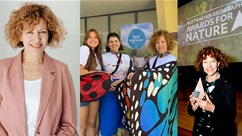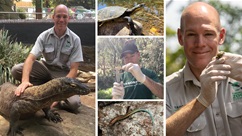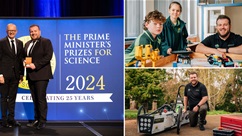KZ: Hi Steve! What are sea slugs, and when did the Sea Slug Census start?
S: Sea slugs are marine snails that, during the process of evolution, have gradually either lost their shell completely, or have a much smaller or thinner shell than most marine snails. Because a shell provides important protection against predators, many sea slugs have developed other ways to defend themselves. Some eat sponges that contain toxic chemicals and use these to make them really distasteful to predators. These species often advertise that they are unpalatable by being brightly coloured. Not only are these colours and patterns effective in deterring predators, but they also make sea slugs one of the most popular subjects for underwater photographers – this is one of the reasons the Sea Slug Census has become so popular. However, as many species are quite small (size range from a few millimetres up to more than 300mm), and some are camouflaged, they are not always easy to see and this means you sometimes have to work hard to find them (this is where knowing about their ecology really helps).
KZ: Why is it important to keep track of sea slugs?
S: Because sea slugs are often easy to see, and very popular with photographers, they represent a very useful indicator of changing environmental conditions. Most sea slugs live for less than 1 year and have very specific requirements for food and shelter. This means that if conditions at a site change (e.g. loss of habitat), then the number and type of sea slugs living there will also change. Having regular Censuses at the same locations provides an indication of natural patterns (baseline) so that we are can detect unusual changes.
KZ: How many people have participated so far, and how many sea slug species have been documented?
S: Since the Sea Slug Census started in 2013, over 3,700 participants have recorded 1,094 species of sea slug. Some of these species have been found at lots of different locations by lots of participants, but 450 species have only been found once. This means that many species are very rare. Even though I’ve participated in well over 60 Sea Slug Censuses so far, I’m always really excited at the start of a new Census, hoping that I might find a new, or rare species (and I have, on lots of occasions)!
KZ: Is the Sea Slug Census specific to Australia?
S: Most Sea Slug Census locations are in Australia, spread out at different locations along the coastline from Port Hedland in north-western Australia, around southern Australia up to the Sunshine Coast in Queensland, and out to Lord Howe Island. Usually, a Census runs for up to 10 days within a specific area at each location (e.g. the Port Stephens-Great Lakes Marine Park, in the Nelson Bay Sea Slug Census). However, there is a lot of interest in starting events overseas as well. So far, Sea Slug Censuses have been run in Vanuatu and three different places in Indonesia (Bali, Komodo and Ambon). More and more locations are included every year and, in 2023, we even ran a census that included the whole of the Great Southern Reef (from Kalbarri in Western Australia to the Sunshine Coast in Queensland).
KZ: Is it possible for children to participate in the Sea Slug Census?
S: Children are some of our best sea slug spotters! While the early Sea Slug Censuses focused on underwater habitats accessible only by snorkelling and diving, we are finding that most species in many events are found in tidepools on rocky shores or in shallow coastal waters. My 12-year-old son, Owen, is one of the best spotters in my team for rock-pooling and snorkelling and has been helping for 8 years! His sharp eyes have detected species I’ve overlooked on many an occasion. We always advise that children are fully supervised by adults at all times and are made aware of the various potential dangers, including dangerous marine life. Participation is always at the participants’ own risk but a commonsense approach is usually sufficient to ensure safe and productive excursions. One of the best tips for safety is to make sure that you seek advice from people who are familiar with the sites you plan to visit.
KZ: What are some of the achievements accomplished by the Sea Slug Census so far?
S: Since 2022, all of the photos taken for the Sea Slug Census are submitted to iNaturalist, an online database covering all life on Earth. When species are photographed in a new place, these records become available to a worldwide audience. This means that the Sea Slug Census is not only providing improved knowledge on the biodiversity of each participant’s local sites, but also contributing to Australia-wide and global knowledge on biodiversity. The species lists from Censuses also provide important information that helps conservation planning for marine habitats. Important outcomes from Censuses, such as changing distributions due to climate change, are also published in scientific journals. So far, data generated by Sea Slug Census events have contributed to 8 scientific papers in international journals, with more currently being written.
KZ: What has been the personal highlight of your career so far?
S: I think the main highlight has been the opportunity to explore marine environments in different parts of the world. While I have enjoyed the teaching and research components of my university positions, there is nothing quite like exploring a new location, especially by diving, and (of course) finding a species of sea slug I haven’t seen before!
KZ: Did you have any hobbies as a child that gave you skills you use at work?
S: I was fortunate to have very supportive parents who encouraged my interest in marine biology even though we lived a long way from the sea. I also remember having a small shell collection from our frequent school holiday visits to South Wales to stay with grandparents. The most important activity that helped feed my passion for marine science, however, was when Mum and I enrolled for a community course in marine science at Sheffield University when I was 12. This really opened my eyes to the wonders of the ocean and strengthened my resolve to become a marine scientist.
Read our Ideas Lab interview with Steve in the June 2024 'Ready Pet Go' issue of K-Zone, on sale now!










Comment Now!